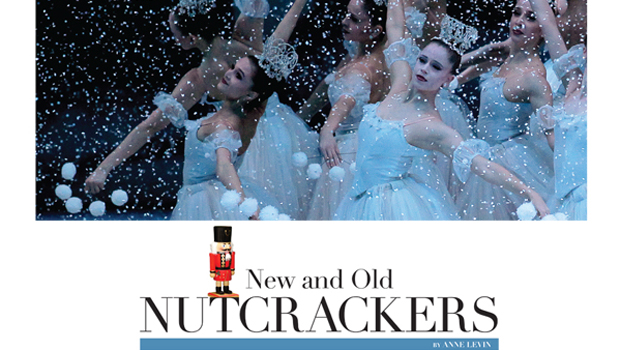New and Old Nutcrackers

By Anne Levin // Photography by Eduardo Patino
When George Balanchine decided to choreograph a version of “The Nutcracker” for his New York City Ballet nearly 60 years ago, it’s doubtful he imagined the two-act production would become a tradition—and a cash cow—not only for his own company, but for ballet troupes all over the world.
The famed choreographer’s “Nutcracker” was based on the ballet he had danced as a child in Russia. He had never forgotten playing the role of the Prince when he was a 15-year-old student at the Imperial Theater Ballet School in St. Petersburg, and he thought New York audiences might take to its magical story and Tchaikovsky’s score. He was right.
The full-length ballet quickly became a mainstay of the company’s repertory. In fact, when the New York City Ballet moved from City Center on West 55th Street to the New York State Theatre (now the Koch Theatre) at Lincoln Center in 1964, the stage floor was specially designed with a pit to accommodate the ballet’s one-ton Christmas tree, which grows to a staggering 40 feet during the first act.
“George Balanchine’s The Nutcracker,” as it is now officially known, is unques-tionably the granddaddy of them all. But numerous other productions, by other choreog-raphers, are also performed today. New York dance audiences are fortunate to have their pick of four distinctly different versions.
In addition to New York City Ballet at the Koch Theatre November 29-January 4, there is American Ballet Theatre’s “Nutcracker” by Alexei Ratmansky, performed at Brooklyn Academy of Music December 13-22. New York Theatre Ballet has a one-act, one-hour “Nutcracker” for young children by Keith Michael, performed at Florence Gould Hall December 14, 15 and 22. And a small company called Dances Patrelle does “The Yorkville Nutcracker,by choreographer Francis Patrelle, at the Kaye Playhouse December 5-8.
Ratmansky, among the most prolific and highly regarded ballet choreographers on today’s dance scene, debuted his “Nutcracker” to much fanfare three years ago. Joan Acocella, the dance critic of The New Yorker, noted that the ballet had “a warm, uncorny sweetness.” Others have commented that the production is more intimate and less dramatic than Balanchine’s. While not as big on special effects as New York City Ballet, this production has vivid costumes and scenery and has gained a following for its focus on relationships and the transformation from childhood to adulthood.
Just because “The Nutcracker” is a family-friendly ballet popular with children doesn’t mean there is skimping when it comes to sophisticated choreography. Balanchine’s “Waltz of the Flowers” is considered by some to be among his most inventive creations. The “Snowflakes” dance and central pas de deux in Ratmansky’s version of the ballet have also received wide acclaim.
For the past 27 years, children have been getting acquainted with the arts at New York Theatre Ballet’s performances of “The Nutcracker” at Florence Gould Hall. Geared to those ages three to six, this streamlined, one-hour version of the story leaves lots of room for youthful comment, should kids care to express themselves. “It’s a completely different experience from Lincoln Center or Brooklyn Academy of Music,” says Diana Byer, the company’s founder and director. “The kids feel they’re part of the story. It’s not just something they’re watching.”
The one-act production, which is said to have attracted such celebrity moms as Sara Jessica Parker and Marcia Gay Harden, was designed as a kind of introduction to the ballet and to theater. “It was an idea of [puppeteers] Jim Henson and Kermit Love. Ker-mit was a very good friend of mine,” Byer said. “He thought it would be a great idea to do a one-hour ‘Nutcracker’ to introduce city kids who had never been to the ballet.”
The action is abbreviated but the costumes and sets are sophisticated. “The goal is for them to have a fabulous theatrical experience where they will want more, and become real theatergoers as they grow up,” Byer said. “We want to get them hungry to go to the theater. Maybe then, they’ll come to our repertory shows and to major ballet companies, and to theater and concerts. It’s a great first experience. It’s positive. And it’s short enough that they’re not going to fall asleep or get cranky."
When Francis Patrelle began considering a production of "The Nutcracker" for dancers from the popular Ballet Academy East, the former dancer thought back to the college degree he earned while studying ballet during his youth in Pennsylvania. “I was a history major,” Patrelle said. “I guess that’s why I started thinking about setting the ballet in a specific place during an important part of New York’s history.”
A famous photograph of skaters on the pond in Central Park around the turn of the century was the inspiration for Patrelle’s idea for “The Yorkville Nutcracker.” Ballet Academy East, where he teaches, in the middle of the Upper East Side Yorkville neighborhood.
“I decided to place the party scene at Gracie Mansion, right down the street,” he said. “And to make it more universal, the Kingdom of Sweets scene is set in the Bronx Botanical Garden. So it’s very site specific, and everybody on that stage is a real character from the history of that area.”
The ballet is now in its eighteenth year. Students from Ballet Academy East and other schools take most of the roles, but each year guest artists from major companies dance the leads. New York City Ballet’s Jenifer Ringer and Jared Angle will play the Sugar Plum Fairy and her Cavalier this year, while Matthew Dibble, who dances for cho-reographer Twyla Tharp and is a former member of England’s Royal Ballet, will take the role of “snow boy.” Dancers from the Boston Ballet and Ohio Ballet also take part.

